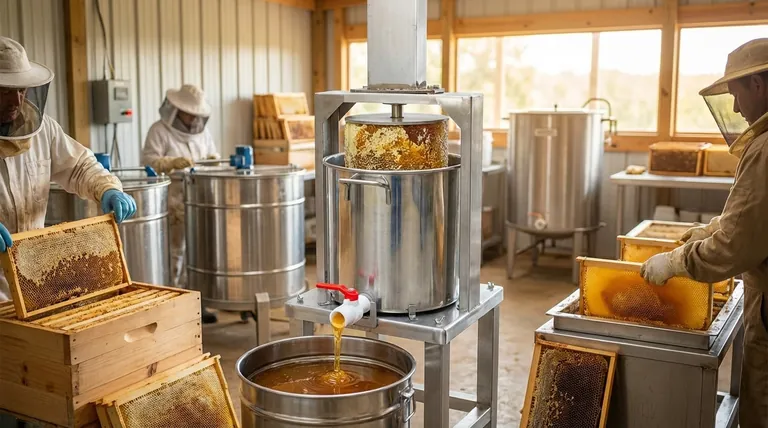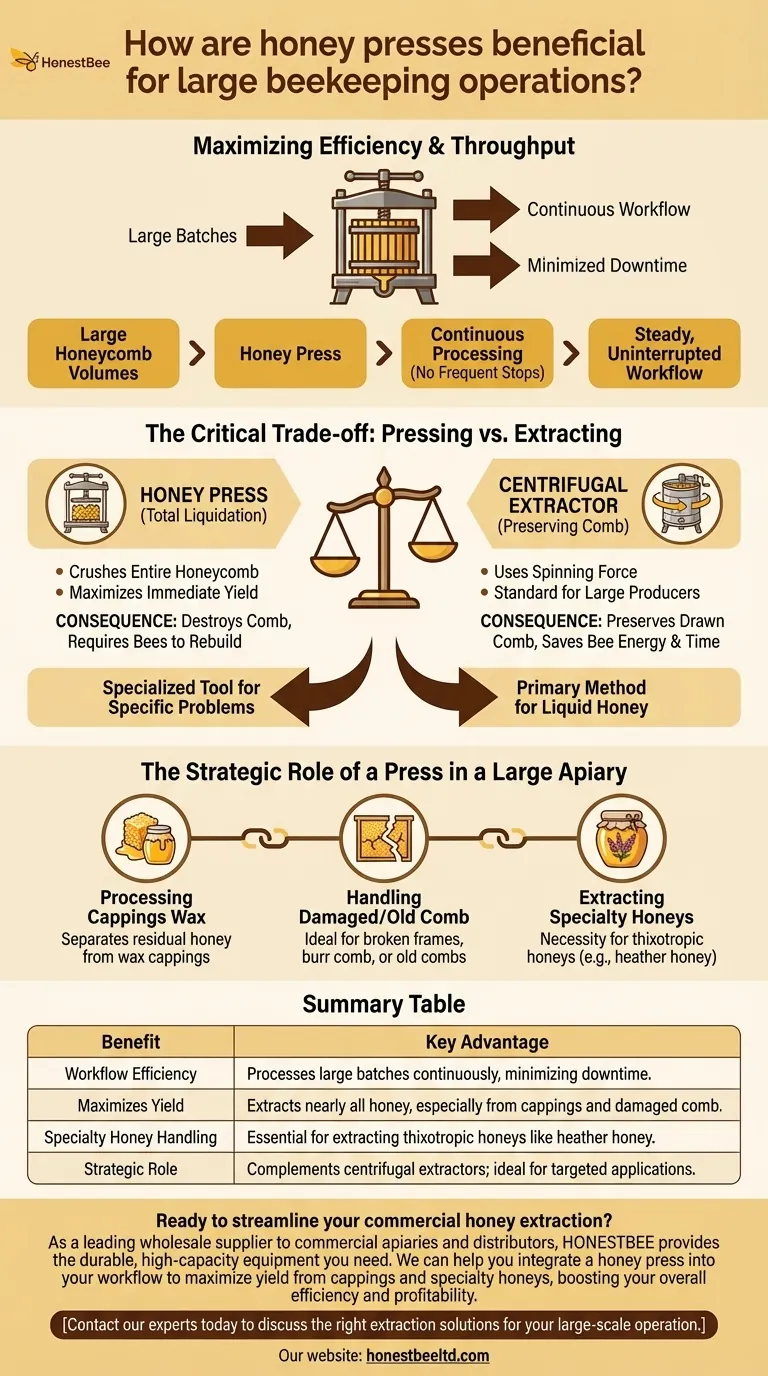Ultimately, a honey press benefits a large beekeeping operation by maximizing efficiency and throughput. It is designed to crush substantial batches of honeycomb in a single run, and its large capacity allows for continuous processing without the frequent stops required to drain smaller equipment. This maintains a steady, uninterrupted workflow essential for commercial-scale harvesting.
A honey press offers raw power for high-volume extraction, but its true value in a large operation is not as a replacement for all other methods. It is best understood as a specialized tool that solves specific problems, centered on the critical trade-off between maximizing immediate honey yield and preserving valuable beeswax comb.

The Core Benefit: Unlocking Workflow Efficiency
For any large-scale agricultural process, minimizing downtime and maximizing output are the primary goals. A honey press is engineered specifically to address these needs during honey extraction.
Processing Larger Batches
A key advantage is the sheer volume of honeycomb a commercial press can handle. This allows an operator to process more frames per hour compared to smaller, hobbyist-level equipment.
Minimizing Downtime
Larger presses have a high holding capacity for extracted honey. This design means the machine can run for extended periods before it needs to be drained, eliminating a significant bottleneck in the extraction process.
Maintaining a Continuous Workflow
The combination of large batch sizes and high capacity creates a smooth, continuous workflow. This is crucial when dealing with the output of dozens or even hundreds of hives, where any stop in the process can cause significant delays.
Understanding the Critical Trade-off: Pressing vs. Extracting
While a press offers a powerful extraction method, it is not the only option. To understand its role, one must compare it to the most common alternative for large operations: a centrifugal extractor. The choice between them comes down to one factor: the fate of the beeswax comb.
The Pressing Method: Total Liquidation
A honey press works by crushing the entire honeycomb—wax, honey, and all—and straining the liquid honey out. This method is incredibly effective at squeezing out nearly every drop of honey locked in the wax.
The Consequence: Destroying the Comb
The downside is that this process completely destroys the comb. Bees expend a tremendous amount of energy and consume significant nectar resources to build their wax comb. Forcing them to rebuild it every season can reduce the overall potential honey surplus of a colony.
The Extractor Method: Preserving the Comb
In contrast, a centrifugal extractor uses spinning force to pull honey out of the uncapped cells. This method is standard for most large honey producers because it preserves the drawn comb. These empty frames can be returned to the hives for the bees to refill immediately, saving them immense time and energy.
The Strategic Role of a Press in a Large Apiary
Given the importance of preserving comb, a honey press in a large operation is rarely the only tool for extraction. Instead, it serves as a powerful, specialized instrument for specific tasks where destroying the comb is necessary or irrelevant.
Processing Cappings Wax
When beekeepers use an extractor, they must first slice off the wax "cappings" that seal the honey cells. These cappings are saturated with honey. A press is the perfect tool for separating this residual honey from the wax, ensuring nothing is wasted.
Handling Damaged or Old Comb
Not all honeycomb is perfect. A press is ideal for extracting honey from broken frames, burr comb, or old combs that need to be cycled out of the rotation anyway.
Extracting Specialty Honeys
Some types of honey, such as heather honey, are thixotropic—meaning they have a gel-like consistency and will not flow out in an extractor. For these specialty products, a press is not just an option; it is a necessity.
Making the Right Choice for Your Operation
The decision to integrate a honey press depends entirely on your operational goals and the type of honey you produce.
- If your primary focus is high-volume liquid honey production: Your core system will be an automated uncapper and a large centrifugal extractor to preserve comb. A press becomes an essential secondary tool for processing the cappings.
- If your primary focus is processing specialty honeys or managing non-standard comb: A honey press will be a central and indispensable part of your extraction workflow.
Ultimately, a honey press is a powerful asset that enables large-scale beekeepers to maximize yield and streamline their workflow for specific, targeted applications.
Summary Table:
| Benefit | Key Advantage |
|---|---|
| Workflow Efficiency | Processes large batches continuously, minimizing downtime. |
| Maximizes Yield | Extracts nearly all honey, especially from cappings and damaged comb. |
| Specialty Honey Handling | Essential for extracting thixotropic honeys like heather honey. |
| Strategic Role | Complements centrifugal extractors; ideal for targeted applications. |
Ready to streamline your commercial honey extraction?
As a leading wholesale supplier to commercial apiaries and distributors, HONESTBEE provides the durable, high-capacity equipment you need. We can help you integrate a honey press into your workflow to maximize yield from cappings and specialty honeys, boosting your overall efficiency and profitability.
Contact our experts today to discuss the right extraction solutions for your large-scale operation.
Visual Guide

Related Products
- 10L Stainless Steel Electric Honey Press Machine
- Stainless Steel Honey Press Wax Press with Tank
- Easy Use Manual Stainless Steel Honey Press for Honey Comb
- Honey Wax Separating Wax Press with Metal Screw Wax Separator Machine
- Stainless Steel Manual Honey Press with Guard for Pressing Honey and Wax
People Also Ask
- What happens to the wax after pressing in a honey press? A Guide to Maximizing Your Hive's Yield
- What are the key features of a honey press? Maximize Yield with Durable, Efficient Extraction
- What are the main differences between centrifugal extractors and honey presses? A Guide for Commercial Apiaries
- What are the benefits of using a honey press for Warré or Top Bar beehives? Maximize Your Natural Harvest
- What are the key features of the stainless steel honey press? Maximize Yield & Guarantee Purity



















